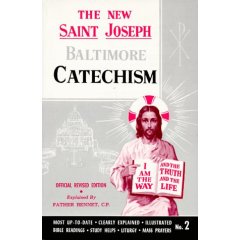
The next time you are making a purchase on amazon, I strongly recommend spending another six bucks on The New Saint Joseph Baltimore Catechism No. 2.
This volume (the second of four) is at the level of preparing Catholic Children for confirmation, typically around age seven.
What is fantastic about this book is that it is both informative and yet delightfully anachronistic. The illustrations and examples will fill you with nostalgia, especially if you are over fifty or a fan of the Mystery Science Theater series, because they are very much in the style of those 1950's short films put out by the government on topics from personal hygiene to atomic power. Tommy knows that a boy's hair should be parted two inches to the left of the center line of his head, and it should be straight and clearly visible. And remember, the atom is your friend.
For example, in a section on "Occasions of Sin" there is a picture of a boy reaching for a pack of cigarettes on a dresser, with an ashtray and matches nearby. The boy reminds himself: "These are my father’s cigarettes. But he told me not to smoke, I'm too young..." In one generation we went from "you're too young to smoke" to "cigarettes are a repulsive habit that will kill you." The cultural change is so interesting. I can't even remember the last time I saw an ashtray. And yet in my lifetime people used to smoke on elevators. Elevators!
As for learning about Catholicism--if you want to learn what Rome teaches you should, at least at first, use the Catholic Church's own resources. There is a lot of bad if not slanderous garbage written by Protestants. There is plenty of material in this book that will point out substantive differences and also many similarities between conservative Catholicism and evangelism. One striking example of the former is on the inside cover of the catechism, where we read:
The faithful who devote twenty minutes to a half hour to teaching or studying Christian Doctrine may gain:In teaching about the Eucharist and transubstantiation, the catechism states:
An indulgence of 3 years. A plenary indulgence on the usual conditions twice a month, if the above practice is carried out at least twice a month.
--Apostolic Brief, March 12, 1930; S. P. Ap., May 26, 1949.
351. Is Jesus Christ whole and entire both under the appearances of bread and under the appearances of wine?Notice what it states, for it is substantive: it argues that the body and the blood are both present in the bread and wine separately. The bread is not only body, and the the wine is not only blood.
Jesus Christ is whole and entire both under the appearances of bread and under the appearances of wine.
The reason for this doctrine, which is to defend the practice of withholding the wine from the laity (because they have a tendency to spill it, which necessitates special cleansing) is not mentioned. If the blood is also present in the bread and not just the wine, then the bread constitutes a complete meal, and the laity is not missing anything by not drinking the wine, so no spills to worry about.
I found quite interesting an explanation as to why transubstantiation doesn't go all the way--that is, why only the substance of the bread changes, but not the appearances:
The appearances of bread would also change into those of Christ if God did not prevent this by a miracle.Of course, in many Protestant churches the extreme opposite view, the Great Absence, is taught: the Lord 's Supper is purely a memorial service, nothing supernatural, no grace being bestowed, no statement about whether or not Christ is present in any manner different from the other three Sundays when the Lord's Supper is safely secured in some kitchen closet.
When the priest says, "This is my body," at Mass, you would immediately see Christ, and not the appearances of bread, if God did not prevent it by a miracle. He keeps the appearances of bread in existence to enable us to eat the flesh of Christ without difficulty. (p. 165)
No comments:
Post a Comment